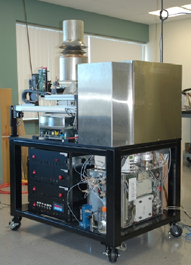S&T Snapshots - Chemical & Biological

BioWatch 3 detectors are now being tested.
Lab-in-a-Box
(June 2007) The state-of-the-art Federal system for monitoring the air to detect harmful biological agents is scheduled for another upgrade--this time, to one that’s fully automated. The defense of the future will involve a self-contained “lab-in-a-box” that can analyze air samples from strategic locations around the clock and quickly alert agencies to a threat … all by itself.
This is the two-pronged goal of research behind the Generation 3 BioWatch Program, which is funded by the Chemical and Biological Division at the DHS S&T Directorate. Specifically, the program--also called BioWatch 3--is seeking to develop a quick-response, early-warning system to replace BioWatch 2. Currently, air samples must be collected manually, and a full laboratory analysis is needed before a threat can be determined.
The key to BioWatch 3, however, will be the Bioagent Autonomous Networked Detector (BAND). BAND will be equipped to automatically collect samples, analyze for threat agents, and then notify nearby authorities remotely if it suspects that an agent is harmful or out of the ordinary. BAND will be capable of aerosol collection, molecular analysis, and the identification of bacteria, toxins, and viruses. The system will also retain an archive of each sample collected for confirmation and forensic analyses.
“The detection technologies for the BAND system may vary across the board,” says Edward Rhyne, who manages the Generation 3 BioWatch Program. “We’re looking at standard laboratory techniques, as well as highly innovative and revolutionary methods.”
BAND will provide other advantages over the current system. It will, for example, be able to detect three times as many biological agents, and it will cost about 70 percent less to operate. This savings will enable an increase in the coverage area from which samples are collected. In addition, BAND will be capable of operating continuously for a 30-day cycle before maintenance is required.
BioWatch 3 is expected to be pilot tested in fiscal year 2008 and fully deployed between fiscal years 2009 and 2012.
This page was last reviewed/modified on September 3, 2008.



